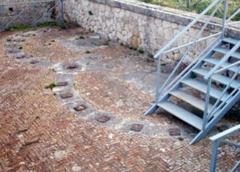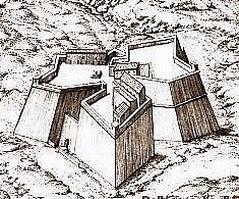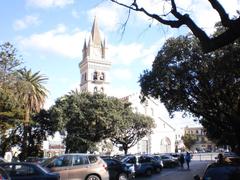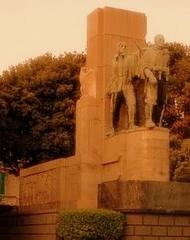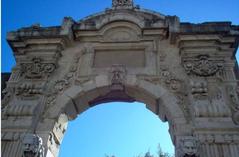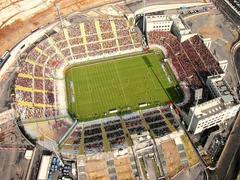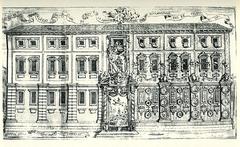Castello di Santo Stefano, Messina, Italy: Visitor Guide, Hours, and Tickets
Date: 14/06/2025
Introduction
Perched in the scenic province of Messina, Sicily, the Castello di Santo Stefano is a captivating testament to the island’s rich and complex past. This medieval fortress, set on a strategic hilltop overlooking the Tyrrhenian Sea, invites visitors to step into a world shaped by Norman, Arab, and Byzantine influences. Known as the Arabo-Norman Castle of Santo Stefano Medio, the site is celebrated for its fusion of military might and artistic detail, reflecting Sicily’s history as a crossroads of civilizations. The castle’s role in regional defense, governance, and culture has secured its place as a significant landmark in Messina’s heritage.
This comprehensive guide delivers everything you need to plan a memorable visit: opening hours, tickets, accessibility, travel tips, historical context, and highlights of nearby attractions. Whether you are a history aficionado, architecture enthusiast, or cultural explorer, Castello di Santo Stefano offers an immersive journey into Sicily’s vibrant past (messina-sicilia.it, Fondo Ambiente Italiano).
Table of Contents
- Introduction
- History of Castello di Santo Stefano and Santo Stefano di Camastra
- Architectural Highlights
- Visiting Information
- Nearby Attractions
- Visitor Experience and Practical Tips
- FAQs
- Conclusion
- References
History of Castello di Santo Stefano and Santo Stefano di Camastra
Medieval Origins and Rebuilding
Castello di Santo Stefano traces its origins to the Norman era (11th–12th centuries), when it was constructed as a defensive and administrative nucleus for the region. The Normans, following their conquest of Sicily, established fortifications like Santo Stefano to safeguard their control and project feudal authority. The castle’s location near the monastery of Santa Croce in Val Demone, and the presence of a Norman church dedicated to Saints Alfio, Filadelfio, and Cirino, underscore its deep medieval roots (messina-sicilia.it).
A catastrophic landslide in 1682 obliterated the original settlement. Duke Giuseppe Lanza championed its reconstruction, giving rise to the new town of Santo Stefano di Camastra. Engineer Carlos de Grunenbergh designed the rebuilt village with a Baroque geometric plan, integrating the castle into a harmonious civic and religious landscape, including the grand Chiesa Madre completed in 1685 (sicily.co.uk).
Architectural Evolution and Artistic Heritage
The castle’s architecture evolved over centuries, blending Norman fortifications with Baroque and later influences. The nearby Palazzo Trabia, dating to the late 12th century, features interiors adorned by the Maestri Stefanesi—master ceramicists whose craft defines the town’s artistic identity. The Church of Maria SS. della Catena, housing the Baroque mural grave of Giuseppe Lanza and Maria Gomez de Silvejra, further attests to the site’s enduring artistic and noble connections (messina-sicilia.it).
Strategic and Economic Role
Strategically poised between the coast and the Nebrodi mountains, the castle was vital in defending against Byzantine, Saracen, and later European threats. Its position also fostered economic prosperity, with Santo Stefano di Camastra gaining renown for its ceramics from the 18th century onward. Today, the town’s vibrant ceramic workshops and shops draw visitors seeking authentic Sicilian artistry (turytrip.com).
Architectural Highlights
Defensive Features and Arabo-Norman Synthesis
The Castello di Santo Stefano is a prime example of Arabo-Norman architecture, a style unique to Sicily that combines Norman military engineering with Arab and Byzantine decorative traditions (Fondo Ambiente Italiano). Key features include:
- Curtain walls and towers: Formidable stone walls punctuated by square towers, providing both defense and vantage points.
- Central keep (donjon): The stronghold’s heart, elevated and highly defensible.
- Gatehouse: Fortified main entrance, often equipped with portcullis and murder holes.
- Cisterns and storage rooms: Designed for siege endurance, reflecting Arab influences on water management.
- Pointed arches and geometric motifs: Evident in windows, doorways, and remaining stonework, showcasing the fusion of styles.
This architectural synthesis is a hallmark of Sicily’s pluralistic medieval society, where diverse communities influenced one another’s building traditions (Italy Magazine).
Visiting Information
Opening Hours and Tickets
- Hours: Tuesday–Sunday, 9:00 AM – 6:00 PM (closed Mondays and major holidays)
- Tickets: Adults €5; discounts for students, seniors, and groups; children under 12 free
- Guided Tours: Available daily at set times; book via the municipal tourism site or on-site
- Accessibility: Partial; some areas may be challenging for visitors with limited mobility—contact in advance for details
Getting There
- By Car: Easily accessible via the Messina-Palermo highway; parking available near the historic center
- By Public Transport: Regular bus connections from Messina to Santo Stefano di Camastra
Best Time to Visit
Spring (April–June) and early autumn (September–October) offer mild weather and fewer crowds, ideal for exploring the castle and local ceramics workshops.
Nearby Attractions
- Museo della Ceramica (Palazzo Sergio): Discover the region’s ceramic traditions
- Chiesa Madre: Baroque church with a striking façade and columns
- Local Artisan Studios: Watch and purchase authentic Sicilian ceramics
- Nebrodi National Park: Hiking, nature, and rural villages nearby (Nebrodi National Park)
Visitor Experience and Practical Tips
- Plan ahead: Check official websites for up-to-date hours, ticketing, and special events.
- What to bring: Comfortable shoes, sun protection, water.
- Facilities: Restrooms and a small visitor center available; some facilities may have limited accessibility.
- Photography: Permitted throughout the grounds; seek permission for drones.
- Local events: Time your visit with events like the Festa della Ceramica for a richer experience.
Frequently Asked Questions (FAQs)
Q: What are the visiting hours?
A: Tuesday to Sunday, 9:00 AM–6:00 PM; closed Mondays.
Q: How much are tickets?
A: Adults €5; discounts for students/seniors; children under 12 free.
Q: Are guided tours available?
A: Yes, at scheduled times—book in advance or on site.
Q: Is the castle accessible for disabled visitors?
A: Some areas are accessible; contact ahead for arrangements.
Q: What other sites are nearby?
A: Museo della Ceramica, Chiesa Madre, Nebrodi National Park, and artisan ceramics workshops.
Conclusion
Castello di Santo Stefano is more than a medieval fortress: it is a living symbol of Sicily’s layered heritage, artistic ingenuity, and enduring spirit. Its unique Arabo-Norman architecture, panoramic vistas, and integration with the vibrant town of Santo Stefano di Camastra offer an unforgettable experience for travelers. Whether exploring the castle, discovering the town’s ceramics, or hiking in the Nebrodi mountains, visitors will find themselves immersed in the rich tapestry of Sicilian history.
Maximize your visit by consulting official tourism resources, leveraging digital tools like the Audiala app, and timing your trip to coincide with local festivals and cultural events. Castello di Santo Stefano stands ready to enchant and educate, inviting all who enter to discover the essence of Sicily’s past and present.
References and Useful Links
- Official Santo Stefano di Camastra Tourism
- Fondo Ambiente Italiano – Castello Arabo-Normanno
- Sicily Tourism: Santo Stefano di Camastra
- Nebrodi National Park
- Italy Magazine: Artworks You Don’t Want to Miss in Sicily
- Savoring Italy: Messina, Sicily
- Turytrip: Things to Do in Messina
For more in-depth historical and visitor information, refer to the sources above and explore the Audiala app for guided tours and interactive content.
